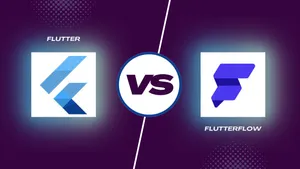
Flutter vs. FlutterFlow: A Quick Comparative Overview
flutter
flutter flow
app development
mobile development
Building an amazing app used to be a complex task, but not anymore! There are tons of tools out there promising to make it fast and easy. Two popular options that have gained significant traction are Flutter and Flutter Flow. While they might share a similar name, they are fundamentally different tools with distinct strengths and use cases.
Flutter, an open-source UI software development toolkit, empowers developers to craft natively compiled applications for mobile, web, and desktop from a single codebase. On the other hand, Flutter Flow is a visual, no-code platform that enables users to build Flutter apps without writing extensive code.
In this article, we'll discuss what makes these two tools different, when to use each one, and how they can help you.
What is Flutter vs FlutterFlow App Development?
To feel the fundamental differences between Flutter and Flutter Flow, it's essential to understand what each platform brings to the table.
Flutter is a comprehensive open-source UI software development toolkit. It provides developers with a vast array of tools and widgets to construct natively compiled applications for mobile, web, and desktop platforms from a single codebase. This approach ensures optimal performance and a native-like user experience across different operating systems. To take advantage of the Flutter's power, developers typically employ the Dart programming language.
FlutterFlow, on the other hand, is a visual, no-code platform designed to streamline the app development process. It offers a drag-and-drop interface where users can assemble app screens, integrate various functionalities, and even manage data without writing extensive code. Flutter Flow generates Flutter code in the background, making it a suitable option for those with limited coding experience or projects demanding rapid development.
How Does Flutter vs FlutterFlow Work?
Flutter
As mentioned previously, Flutter's development process revolves around the Dart programming language. Developers construct user interfaces using a rich collection of pre-built widgets. These widgets serve as the building blocks for creating complex layouts and interactions. Flutter's hot reload feature significantly accelerates development by allowing developers to see changes in the app's UI instantly without needing to restart the entire app. This iterative development approach enhances productivity and efficiency.
FlutterFlow
FlutterFlow takes a fundamentally different approach. It provides a visual interface where users can drag and drop pre-designed UI components to build app screens. This no-code methodology eliminates the need for writing extensive code, making it accessible to a broader audience. Behind the scenes, FlutterFlow generates Flutter code based on the visual design. While this approach offers rapid development, it might have limitations when it comes to highly customized and complex app functionalities.
Key Differences Between Flutter and Flutter Flow
Choosing between Flutter and Flutter Flow depends on several key factors. Let's break down the primary differences in the table:
Flutter and FlutterFlow cater to different developer profiles and project needs. By carefully considering these factors, you can select the right tool for your app development journey.
What Apps Use Flutter and Flutter Flow?
Both Flutter and Flutter Flow have been adopted by a diverse range of developers to build a variety of applications.
Flutter
Flutter's versatility has led to its adoption in creating a wide spectrum of apps, including:
Ecommerce platforms: Delivering high-performance shopping experiences with rich animations and interactions.
Enterprise applications: Developing robust and scalable business solutions with complex functionalities.
Social media apps: Building engaging user interfaces with smooth scrolling and real-time updates.
Gaming apps: Creating immersive gaming experiences with stunning graphics and responsive controls.
FlutterFlow
While relatively newer, Flutter Flow has gained traction for building:
Prototypes and MVPs: Rapidly creating minimum viable products to test market viability.
Internal tools and dashboards: Developing custom tools for businesses without extensive coding resources.
Simple ecommerce and information apps: Building basic online stores and content-focused applications.
Conclusion
Flutter and FlutterFlow represent two distinct approaches to app development, each with its own strengths and weaknesses. While both offer the ability to build cross-platform applications, the optimal choice depends on factors such as development expertise, project complexity, and desired level of customization.
For developers seeking maximum control, performance, and flexibility, Flutter is the preferred option. Its open-source nature, coupled with the power of the Dart programming language, enables the creation of highly sophisticated and tailored applications.
On the other hand, FlutterFlow caters to a broader audience, including those with limited coding experience. Its visual interface and rapid development capabilities make it an attractive choice for prototyping, building MVPs, and creating simpler apps.
Ultimately, the best way to determine the right tool for your project is to carefully evaluate your specific needs and constraints. Experimenting with both platforms can provide valuable insights into their capabilities and help you make an informed decision.
Need help deciding or have an app idea in mind? Reach out to us – we're here to assist you!


